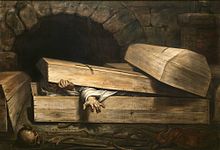Taphephobia
Taphephobia , also taphophobia ( gr. Ταφηφοβία taphephobia , from τάφος táphos "grave" and phobia ) describes the fear of being buried alive as a seemingly dead .
background
The fear of being buried alive is not just a form of phobia , but has a real historical background: In earlier times it was quite possible that people were thought to be dead even though they were still alive. These pseudo-dead were buried and only came to in the coffin deep underground and suffocated in agony. The fact that someone had been buried alive was usually only recognized after they had been transferred to another bed , when the skeleton was in a twisted position in the coffin or scratches were visible on the inside of the coffin.
Some technical aids were devised to escape this situation, such as a cord with which the possibly pseudo-dead could trigger a bell at the grave or unfold a signal flag. Even coffins with an oxygen supply have been constructed.
In order to avoid waking up in the closed coffin and the agony that followed, some people (including Johann Nestroy and Arthur Schnitzler ) had the "heart prick", which means that after their real or supposed death, the corpse or the apparent death were pierced had to. With the same intention, Hans Christian Andersen ordered the arteries of his corpse to be cut open. As long as he was alive, when he went to sleep, he always put a piece of paper next to his bed with the note: "I am just seemingly dead." In his will , the philosopher Arthur Schopenhauer decreed that he could only be buried when his body showed clear signs show the putrefaction .
Nowadays, the risk of being buried alive is as good as ruled out thanks to reliable diagnostic options (obligation to perform an external, possibly also an internal, post-mortem examination with the determination of certain signs of death , in the clinics of intensive care patients also, for example, EEG as part of brain death diagnostics).
Taphephobia in literature, film and art
In the 19th century, the fear of being accidentally buried alive became a motif in literature. Edgar Allan Poe suffered from this then justified concern. Some of his works deal with this fear. B. filmed by Roger Corman in 1962 under the title Lebendig Burial ( The Premature Burial ) with Ray Milland in the leading role.
- Edgar Allan Poe , Buried Alive (short story)
- Gottfried Keller , Buried Alive (cycle of 14 poems)
- Franz Hartmann , buried alive
In Giuseppe Verdi's opera Aida , the Egyptian general Radames is walled up alive. Aida, daughter of the Ethiopian king, hides in the burial chamber and dies with Radames.
literature
- Dominik Groß : The treatment of apparent death in the medical legislation of the Kingdom of Württemberg (1806-1918). In: Würzburg medical history reports. Volume 16, 1997, pp. 15-33.
Individual evidence
- ^ Apparent death: Bell in the coffin Der Spiegel, November 20, 1967.
